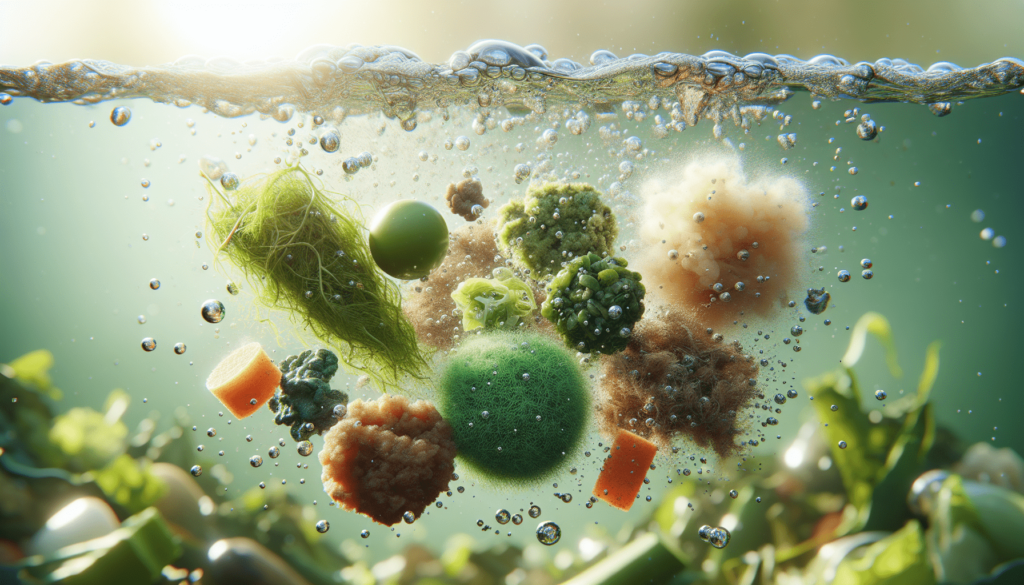Have you ever wondered how the solids found in wastewater can affect the treatment process? It’s an interesting question that underlines a critical part of our global infrastructure. Organic solids play a key role in wastewater treatment, impacting everything from the efficiency of treatment systems to the quality of the water that ultimately gets released back into the environment.

Understanding Organic Solids
What exactly falls under the umbrella of organic solids in wastewater? Essentially, organic solids are any organic matter that is suspended or dissolved in the water. This can range from food scraps and human waste to residues from industrial processes. These solids must be managed effectively to minimize their environmental impact and ensure the efficiency of wastewater treatment systems.
Types of Organic Solids
There are a few different types of organic solids you need to be aware of:
- Volatile Solids
- These are materials that can be vaporized during the treatment process. They primarily consist of biodegradable organic matter and can be broken down by microorganisms during treatment.
- Non-Volatile Solids
- These solids remain after the organic matter has been decomposed. They include inorganic materials such as sand, silt, and clay. While not biodegradable, they still occupy space and can affect treatment efficiency.
- Microbial Biomass
- This refers to the mass of microorganisms present in the treatment process. It plays a pivotal role in breaking down organic solids but can also contribute to the total solids in the water.
Understanding these categories is essential because each type has different implications for wastewater treatment processes, from their breakdown to their disposal.
The Role of Organic Solids in Wastewater Treatment
You might be curious about how these organic solids function in various treatment processes. This is where it gets truly fascinating! Organic solids interact with microorganisms, and this interaction is crucial for effective wastewater treatment.
Biodegradation Process
At the heart of wastewater treatment is the biodegradation process, where microorganisms break down organic solids into simpler compounds. Here’s how it works:
- Initial Breakdown: Larger organic solids are broken down into smaller pieces by physical and chemical processes in the treatment facility.
- Microbial Activity: Once reduced in size, these solids become food for bacteria and other microorganisms. As these microbes consume the organic matter, they convert it into biomass and simple by-products like carbon dioxide and water.
- Stabilization: The remaining organic material is stabilized, meaning it becomes less likely to decompose further — an essential step before any solids can be safely disposed of or repurposed.
This biological reaction is critical. The more solids that can be broken down, the less waste remains after treatment, leading to a more efficient and effective wastewater management process.
Impact on Treatment Efficiency
Did you know that the amount and type of organic solids present can significantly influence treatment efficiency? That’s right! Here are some factors to consider:
- Solids Concentration: A higher concentration of organic solids can create an overloaded system, making it difficult for microorganisms to process the waste effectively. This can lead to longer treatment times and potentially lower water quality.
- Nutrient Availability: Organic solids are rich in nutrients, which are vital for microbial growth. However, an imbalance can lead to eutrophication, where excessive nutrients can harm aquatic life when the treated water is released back into natural water bodies.
- Toxicity: Some organic solids may contain toxins or harmful substances, which can negatively affect the microbial population essential for treatment. This can make it more challenging to manage the treatment process efficiently.
Being aware of these factors can help improvement in wastewater treatment systems, and ultimately lead to enhanced environmental protection.https://www.youtube.com/embed/FvPakzqM3h8
Traditional vs. Advanced Treatment Methods
You might be wondering about the different methods available to treat wastewater and how organic solids fit into these strategies.
Traditional Treatment Methods
Traditional methods such as activated sludge processes have long been the cornerstone of wastewater treatment. In such systems, organic solids undergo biological treatment by mixing them with activated sludge containing mixed microbial populations.
Being aware of traditional methods offers general guidelines for managing organic solids:
- Sedimentation: Solids are allowed to settle in sedimentation tanks, separating settled sludge from treated effluent.
- Aerobic Treatment: Microorganisms consume organic matter in the presence of oxygen, resulting in the breakdown of solids.
- Anaerobic Digestion: In this oxygen-free environment, bacteria decompose organic matter, producing biogas that can be harnessed for energy.
Advanced Treatment Methods
With increasing concerns about environmental sustainability, advanced treatment methods have emerged, focusing on optimizing the breakdown of organic solids and enhancing treatment efficiency.
- Membrane Bioreactors (MBR): These combine biological treatment with membrane filtration, separating solids and liquids more effectively. MBR systems can yield higher-quality effluent.
- Biological Nutrient Removal (BNR): These processes specifically target the removal of nitrogen and phosphorus, often present in organic solids, to prevent eutrophication in receiving waters.
- Advanced Oxidation Processes (AOP): AOPs use strong oxidants to break down complex organic compounds into simpler by-products and are effective in treating wastewater with high concentrations of organic solids.
Recognizing the advantages of advanced methods can guide you toward more efficient treatment solutions, ensuring a balanced approach to handling organic solids.
Monitoring Organic Solids in Wastewater Treatment
To maintain the efficiency of any wastewater treatment process, it’s important to monitor the concentration and composition of organic solids carefully. You might ask, how do treatment facilities go about this?
Sampling Techniques
Various sampling techniques can be employed to analyze the organic solids present in wastewater:
- Grab Sampling: This involves collecting a single sample at a specific time. This method may not provide a complete picture since concentrations can fluctuate.
- Composite Sampling: This technique aggregates multiple samples collected over a period, giving a more representative overview of the solids’ concentration and composition.
- Continuous Monitoring: Advanced facilities may employ online sensors to track the real-time concentration of organic solids, providing valuable data for immediate adjustments.
Using proper sampling techniques is crucial because it informs adjustments in treatment processes, ensuring they remain effective and within regulatory requirements.
Analytical Methods
Once samples are collected, laboratories employ several analytical methods to determine the quantity and characteristics of organic solids:
- Total Solids (TS): A measure of all solids in the wastewater, both volatile and non-volatile.
- Volatile Solids (VS): Reflecting the organic portion, higher values indicate more biodegradable materials present.
- Chemical Oxygen Demand (COD): This test estimates the amount of organic compounds that can be oxidized, providing insights into organic pollution levels in the wastewater.
By understanding these analytical methods, you can appreciate how they contribute to optimizing treatment processes and maintaining environmental standards.

Challenges and Solutions in Managing Organic Solids
While managing organic solids is crucial for effective wastewater treatment, there are several challenges that facilities might face. Here, we discuss these challenges and potential solutions.
High Concentrations of Organic Solids
When wastewater contains an excessive amount of organic solids, treatment systems can become overwhelmed. This can lead to increased treatment times and poorer effluent quality.
Solution: Implementing pre-treatment processes, such as screening and grit removal, can help reduce solids before they enter the main treatment phase. This step can ultimately enhance treatment efficiency.
Presence of Toxic Compounds
Certain organic solids may harbor toxic compounds that can adversely affect microbial communities, thus hampering the treatment process.
Solution: Regular monitoring and characterizing incoming waste can help identify toxic materials early on. Implementing pre-treatment steps for removing or mitigating these materials can save the microbial communities and improve overall treatment efficacy.
Variability in Waste Composition
The composition of wastewater can fluctuate significantly throughout the day, complicating treatment processes.
Solution: Adaptive management strategies, such as adjusting operational parameters in response to real-time monitoring data, can help facilities remain efficient. This flexibility can help accommodate variations in organic loads.
By staying ahead of these challenges with proactive strategies, you can ensure that wastewater treatment remains efficient and effective.
The Benefits of Effective Organic Solid Management
When organic solids are managed effectively in wastewater treatment processes, numerous benefits can arise, not only for the treatment facilities but also for the environment and the community.
Enhanced Water Quality
Efficient management of organic solids leads to higher-quality effluent, better suited for discharge into natural bodies of water or for reuse in irrigation and other applications.
Resource Recovery
By breaking down organic solids responsibly, facilities can also capture biogas, a renewable energy source. This can contribute to energy needs or even produce fertilizers by digesting organic materials through anaerobic digestion.
Regulatory Compliance
Ultimately, effective organic solid management helps wastewater treatment facilities adhere to environmental regulations, reducing the risk of penalties and ensuring the protection of local ecosystems.
You can see that managing organic solids in wastewater treatment doesn’t just improve processes — it has far-reaching effects that can benefit everyone involved.
Conclusion
When you consider the fundamental role that organic solids play in wastewater treatment, it’s clear that understanding their impact can lead to more effective treatment solutions. By recognizing the types and characteristics of these solids, monitoring them, and employing both traditional and advanced treatment methods, facilities can yield higher-quality effluents and contribute positively to environmental sustainability.
As technology evolves, the management and treatment of organic solids will need to adapt too, ensuring a resilient future for wastewater treatment systems. Understanding this dynamic relationship will not only help you appreciate the complexity of wastewater management but also encourage further exploration into innovative solutions for our ever-evolving environmental challenges.